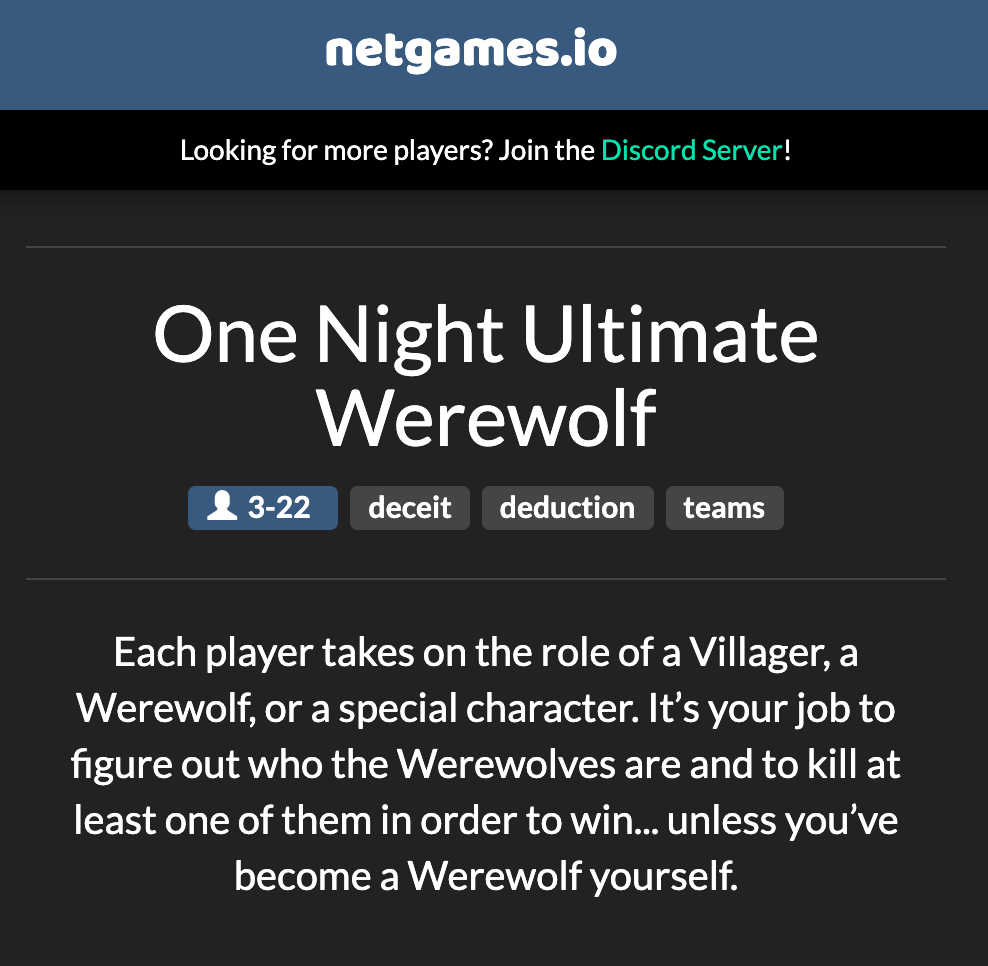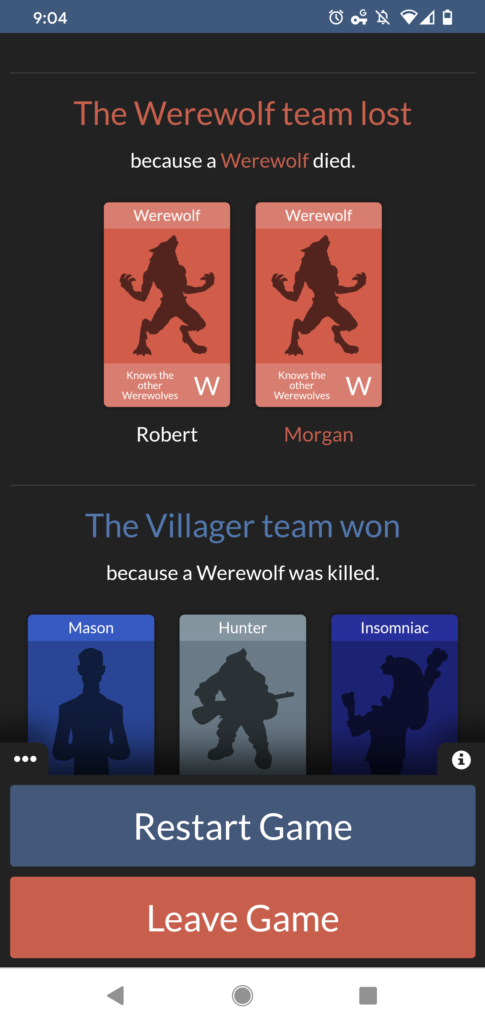This week, 10 of us got together over Zoom to play Werewolf online. We attempted to play the mobile version by Bezier Games, and quickly realized after everyone installed the app, that it required everyone to be in the same space using one shared card deck. Since this did not meet our needs, we shifted to using the browser version made by Netgames.io.

Formal Elements
Players: The game is designed for 7-15 players each of whom have secret identities and belong to one of two teams: team werewolf or team villager.
Objectives: To win the round (which takes place over the course of one day and one night) and survive. Team Villager wins if they kill at least one werewolf. Team Werewolf wins if no werewolves are killed.
Rules: Every player gets a character card and they must keep it a secret. Certain cards have special abilities (e.g., the seer can see the character of another player during the Night).
Procedures: The game alternates between Night and Day rounds, starting with the Night. During the Night, characters take turns awakening in order to do an action. Some actions might include swapping players cards. Night is over once all the characters have their turn and then Night turns to Day. During the Day, players can deliberate and recount what happened in the Night in order to identify who they want to kill (e.g., who might be the werewolf). After 10 minutes, Day is over an each player must immediately select someone to kill.
Resources: Character cards
Boundaries: The emotional space between players and unplayed cards in the center of the “magic circle.”
Outcomes: To produce a winner by identifying and killing or failing to kill someone on Team werewolf.
Types of Fun
Fellowship: Given that there are two teams (player elements), part of the fun in is trying to identify your allies.
Challenge: There is fun in attempting to correctly identify who is on Team Werewolf. This can be challenging given that there are so many players and roles to keep track of, as well as activities during the Night that are designed to confuse players (e.g. card swaps). There is also a sense of challenge in discerning how much to share about your account of the Night or your character during the Day (element of procedure and strategy). For example, seers have the advantage of seeing another players identity, but if they come across as the obvious seer, they could become a target for the werewolves.
Narrative: Given that many events occur during the Night depending on the character cards drawn, the game also invites a sense of story into the game. For example, the roles such as Witch, Seer, and Hunter evoke different dimensions of the story. During the Day, there is challenge in pieces together all the various components of the fragmented story.
Opportunities for Improvement
Despite the clear objective of the game, the online adaptation comes with a steep learning curve for new or in-person to online convert players. The first challenge occurred during the setup of the game. The app requires the host to select the roles to include. As a first time player, I relied on experienced players to describe the ideal setup. It was unclear which roles were villagers and what their powers were. There was no guidance around how many werewolves to include for a group of 10 players. Experienced players mentioned how helpful it can be to have a narrator. However, this version did not support a narration role.

In terms of dynamics, the day time conversation amongst players left more to be desired. It is hard to make accusations and assumptions of players after a single night of play. It turns out that One Night Werewolf is a different game than Werewolf, which is played over several days and nights. We played a couple more times, and we decided that the online game did not deliver on its promise of fun. For example, one player accidentally shared their werewolf identity which resulted in a quick and anticlimactic win for the villagers. As first time players, I would have appreciated a Tips & Tricks resource outlining different strategies for the game. It also would have been a lot more fun and easy to follow with narration and/or scaffolding around what was happening during the Night.

Conclusion
In conclusion, Werewolves is clearly a popular and beloved game when it is played in person. However, it does not transfer well to an online format. One thing that can be done to improve the experience is to call out ahead of time that One Night Ultimate Werewolf is a different experience than the in-person game which happens during multiple rounds. It would also be helpful to have a narrator role that can help describe what happened during the Night before players have time to discuss, deceive, and conspire against other players. More structure and scaffolding throughout the game would have provided the support needed for new players to understand the strategies and intricacies of the game. I look forward to playing this game in person and evaluating its merits beyond the very limited “one night” and online version experience.



